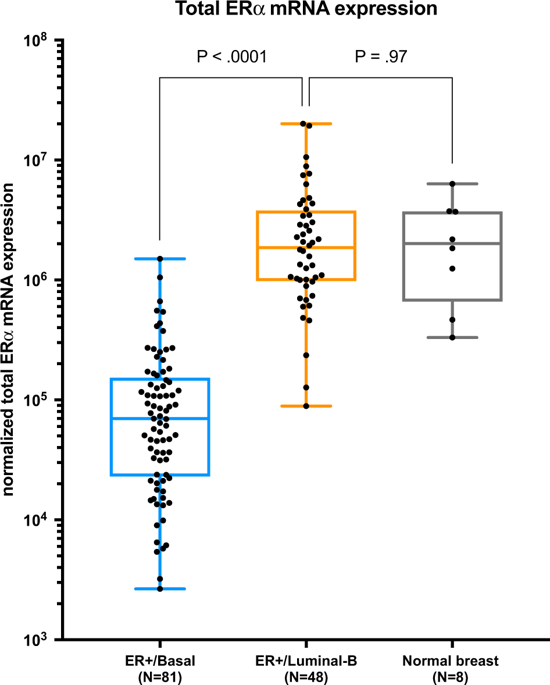npj Breast Cancer ( IF 6.5 ) Pub Date : 2019-04-18 , DOI: 10.1038/s41523-019-0109-7 Floris H. Groenendijk , Tina Treece , Erin Yoder , Paul Baron , Peter Beitsch , William Audeh , Winand N. M. Dinjens , Rene Bernards , Pat Whitworth

|
Immunohistochemically ER-positive HER2-negative (ER+HER2−) breast cancers are classified clinically as Luminal-type. We showed previously that molecular subtyping using the 80-gene signature (80-GS) reclassified a subset of ER+HER2− tumors to molecular Basal-type. We report here that molecular reclassification is associated with expression of dominant-negative ER variants and evaluate response to neoadjuvant therapy and outcome in the prospective neoadjuvant NBRST study (NCT01479101). The 80-GS reclassified 91 of 694 (13.1%) immunohistochemically Luminal-type tumors to molecular Basal-type. Importantly, all 91 discordant tumors were classified as high-risk, whereas only 66.9% of ER+/Luminal-type tumors were classified at high-risk for disease recurrence (i.e., Luminal B) (P < 0.001). ER variant mRNA (ER∆3, ER∆7, and ERα-36) analysis performed on 84 ER+/Basal tumors and 48 ER+/Luminal B control tumors revealed that total ER mRNA was significantly lower in ER+/Basal tumors. The relative expression of ER∆7/total ER was significantly higher in ER+/Basal tumors compared to ER+/Luminal B tumors (P < 0.001). ER+/Basal patients had similar pathological complete response (pCR) rates following neoadjuvant chemotherapy as ER−/Basal patients (34.3 vs. 37.6%), and much higher than ER+/Luminal A or B patients (2.3 and 5.8%, respectively). Furthermore, 3-year distant metastasis-free interval (DMFI) for ER+/Basal patients was 65.8%, significantly lower than 96.3 and 88.9% for ER+/Luminal A and B patients, respectively, (log-rank P < 0.001). Significantly lower total ER mRNA and increased relative ER∆7 dominant-negative variant expression provides a rationale why ER+/Basal breast cancers are molecularly ER-negative. Identification of this substantial subset of patients is clinically relevant because of the higher pCR rate to neoadjuvant chemotherapy and correlation with clinical outcome.
中文翻译:

ER阳性基础型乳腺癌中的雌激素受体变异体对ER阴性乳腺癌等治疗有反应
免疫组织化学ER阳性HER2阴性(ER + HER2-)乳腺癌在临床上被分类为Luminal型。先前我们证明了使用80基因签名(80-GS)进行的分子亚型化将ER + HER2-肿瘤的子集重新分类为分子基础型。我们在此报告分子重新分类与显性阴性ER变体的表达相关,并在前瞻性新辅助NBRST研究(NCT01479101)中评估对新辅助疗法的反应和结果。80-GS将694例中的91例(13.1%)通过免疫组化将Luminal型肿瘤重新分类为分子基础型。重要的是,所有91例不一致的肿瘤均被归为高危,而只有66.9%的ER + / Luminal型肿瘤因疾病复发而被归为高危(即Luminal B)(P <0.001)。对84例ER + /基础肿瘤和48例ER + / Luminal B对照肿瘤进行了ER变异mRNA(ER∆3,ER∆7和ERα-36)分析,发现ER + / Basal肿瘤中的总ER mRNA显着降低。与ER + / Luminal B肿瘤相比,ER + / Basal肿瘤中ER∆7 /总ER的相对表达显着更高(P <0.001)。ER + / Basal患者在新辅助化疗后的病理完全缓解率(pCR)与ER- / Basal患者(34.3 vs. 37.6%)相似,并且远高于ER + / Luminal A或B患者(分别为2.3和5.8%)。此外,ER + /基础患者的3年远距离无转移间隔(DMFI)为65.8%,分别显着低于ER + / Luminal A和B患者的96.3和88.9%(log-rank P <0.001)。总ER mRNA的显着降低和相对ER∆7显性阴性的相对变体表达的增加,为ER + /基础乳腺癌在分子上为ER阴性提供了理论依据。由于新辅助化疗的较高pCR率以及与临床结果的相关性,因此,对这一大量患者的鉴定在临床上具有相关性。











































 京公网安备 11010802027423号
京公网安备 11010802027423号